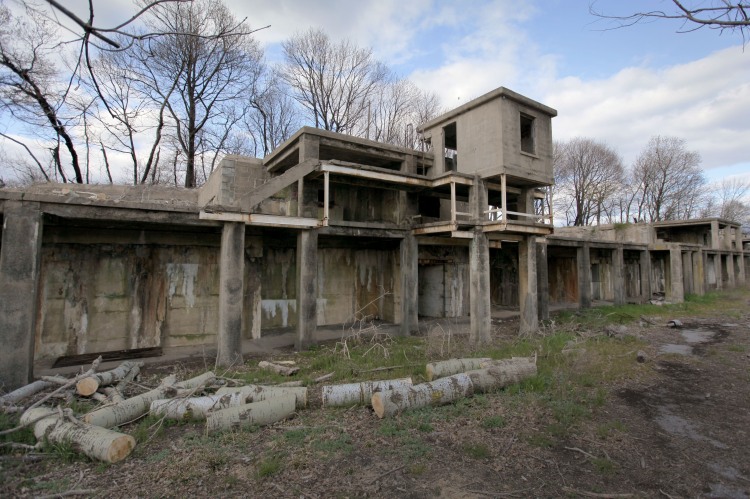AbandonedNYC
New York City Park
Inside Fort Totten: Part 1
Fort Totten sits on a far-flung peninsula of the Long Island Sound, forming the Northeast corner of Queens. The grounds of this defunct military installation turned underfunded public park are home to over 100 historic buildings representing a series of changes that have taken place over the area’s quiet 200 year history. Unfortunately, the majority of these stuctures have been disused for decades, and many are in a state of progressive collapse. With so much of Fort Totten closed off with caution tape, overtaken with vines, or hidden beneath rusty fences, it makes for an unconventional park, but a fascinating place to wander.
An 1829 farmhouse predating the land’s military use crumbles behind a weedy barricade; out front, a prominent sign bears the inscription: “Please Excuse My Appearance, I am a Candidate for Historical Preservation.” It’s an image that typifies the current state of affairs in the Fort Totten Historic District.
On the northern tip of Willet’s Point, a monumental granite fortification constructed during the Civil War as a key component of the defense of the New York Harbor sits unoccupied, though it’s used as a haunted house on occasion. Clustered on the rest of the grounds, dozens of dilapidated Romanesque Revival and Queen Anne Style officers’ quarters, hospitals, bakeries, movie theatres, and laboratories vie for restoration, but so far the funding has failed to materialize.
One such building, a two-story YMCA facility built in 1926, has been abandoned for close to 20 years, but much of what’s left behind lies undisturbed. On a bulletin board in an upstairs landing, a 1995 thank-you letter from a kindergarten class at PS 201 hangs by a crude depiction of Santa Claus, both lovingly dedicated to an Officer Rivera. Steps away, in a rotting book room, an incongruous stash of 80s porno magazines.
Most recently used as a community relations unit of the New York City Police Department, the building is cluttered with mattresses, discarded packaging, and unopened toy donations. The New York City Fire Department, which now operates training facilities in a renovation abutting the hospital building, currently uses the attached gymnasium as a storage space. The basement was filled with rusted-through shelving and ruined equipment, flooded and too dark to shoot.

An overgrown pit in a World War I battery.
On the other side of the peninsula, a series of concrete batteries sit half-submerged in plant life. These were constructed at the turn of the century, but by 1938, they were declared obsolete and subsequently abandoned. The boxy design looks like modern architecture to me, but the battery reveals its true age in other ways.
Pencil-thin stalactites ornament the ceiling wherever the rain gets in, suspended over a crank-operated machine designed to lift heavy weaponry a century ago. The network of maze-like tunnels feature arched hallways with metal doors, winding staircases, and yawning pits, all fit for a dungeon. Guards stationed at the fort were laid off in 2009, and it was unclear on my visit if the area was open to the public or not. A rusty barrier, more hole than fence, didn’t keep out a couple of high school kids, but offered a spot for them to park their bikes.
When the military base changed hands in 2005 and became an official New York City Park, Bloomberg predicted that Fort Totten was “certain to become one of New York’s most popular parks.” Some community members feared that the estimated 450,000 yearly visitors would disrupt parking, increase crime, and change the face of the neighborhood, but ten years later, tourism has yet to pose a problem.
Fort Totten hasn’t lived up to its potential just yet, but the progress that has been made gives hope for improvements to come. The park now offers regular events and educational programs to draw visitors and enrich the surrounding community. Several nonprofit groups have occupied and renovated the decrepit buildings, including the landmarked Officers’ Club, which now serves the Bayside Historical Society as an educational facility and exhibition and event space. These are small but significant victories in the effort to save the historic legacy of a little-known plot that could be the crown jewel of Queens parkland.
(Though in some cases, it may be too little, too late. One look inside the profoundly decayed Fort Totten Army Hospital, in Part 2 of this post, will assure you of that.)
-Will Ellis
Related Links:
- Fort Totten Historic District Designation Report
- Fort Totten History from the Bayside Historical Society
- NYTimes 1999 “Fort Totten’s Old Houses are Tottering”
- NYTimes 2003 “Nearer to a Fort Totten Park but Not to a Consensus”
- Scouting NY—A Snowy Day at Fort Totten

This room must have provided temporary housing to minors. The floor was littered with clothing and old English projects.

In the opposite corner, a derelict dollhouse. If I had been in the Twilight Zone, I’d have found a miniature me in there.

Some rooms held a few remnants…















